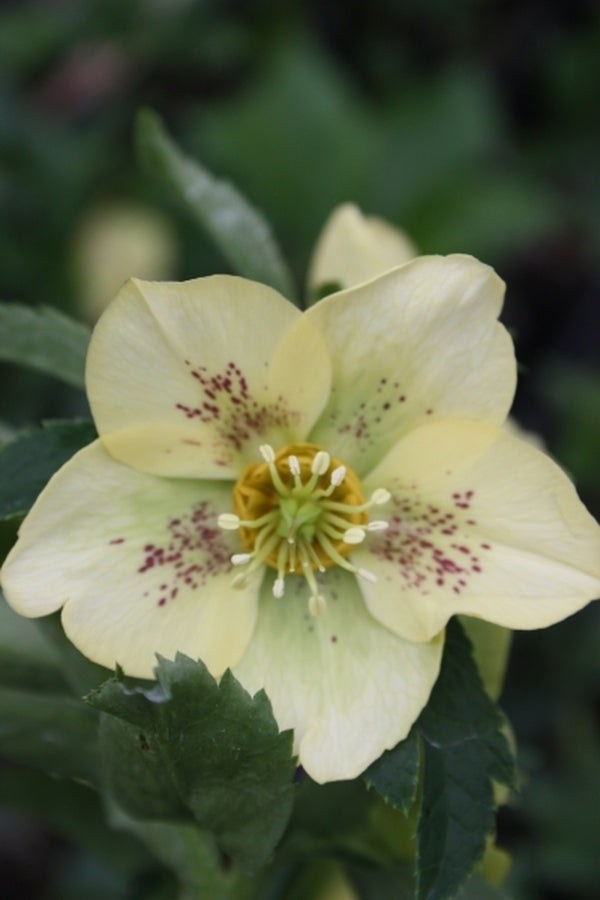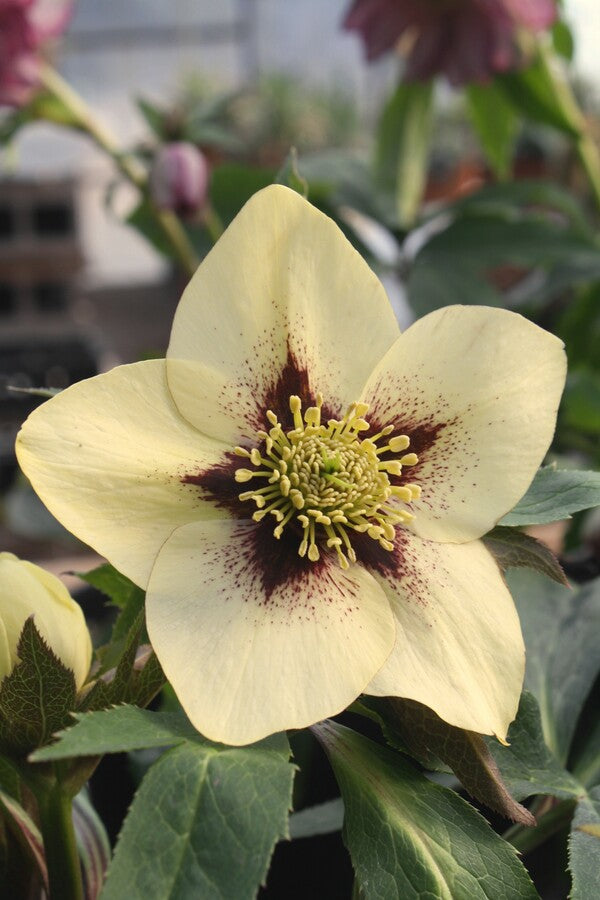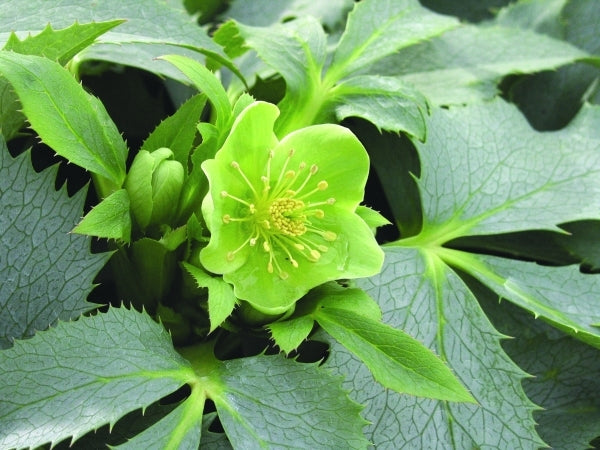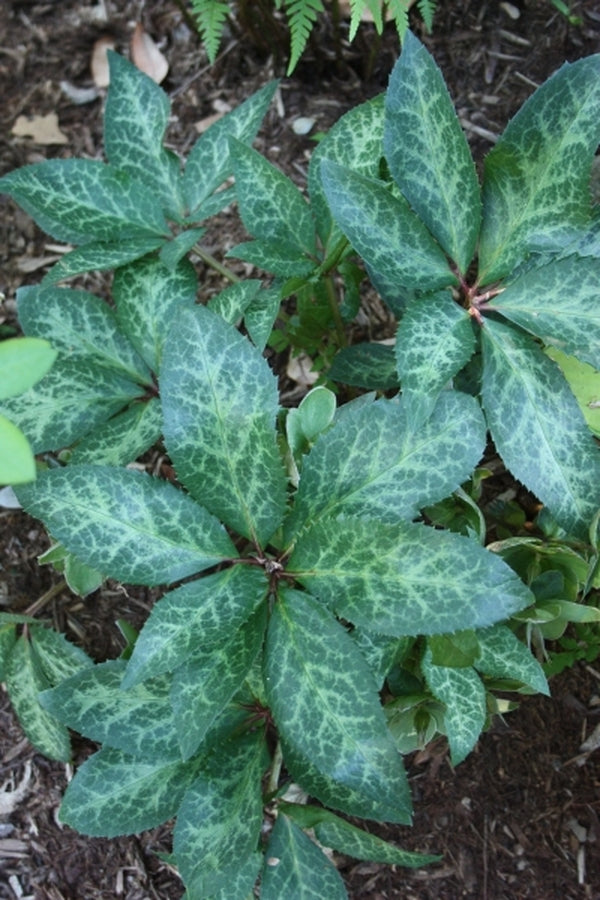Quick Helleborus Tips
Check out our Hellebores production video. The best time to shop for Hellebores is in February and March when the selection is largest and the plants are in flower.Keep an eye out out for Hellebore sales from April onward as their flowering season winds down. Selection is smaller, but this is a great time to pick up a bargain.
A Primer on the Genus Helleborus
There are few perennials that can rival the seasonal interest of hellebores ... often called Christmas or Lenten Rose. These staples of the winter garden are among the most coveted of garden plants by those who know them, yet they are still relatively unknown outside of plant enthusiast circles. Because they don't flower quickly from seed and often finish flowering before most folks visit garden centers, hellebores are rarely found at the lower end mass merchants. 
Helleborus x lemperii 'Walberton's Rosemary' PP 19,439
Hellebores have long been grown in gardens, although originally for their medicinal properties. Hellebores are filled with alkaloid toxins and have been used both as a poison and a purgative. Because of their toxicity, Hellebores are prized as deer-resistant garden plants for areas suffering from deer or similar wildlife pressures.
A true testimonial for the durability of Hellebores are those growing at the old Raleigh garden of NC's famed garden writer, the late Elizabeth Lawrence. Her Raleigh home, from which she moved in the 1940's, is still filled with wonderful clumps of Helleborus x hybridus, despite being used as a fraternity house for several decades!
Hellebores are renowned for their tolerance of drought and neglect, although they truly thrive when grown in a moist, but well-drained soil. They are very sensitive to poor drainage, so be sure your soil drains well. Because Hellebores naturally become very rootbound in containers, it is important when container-grown plants are put in the ground, to remove the potting mix and loosen the roots. This will make it much easier to keep the hellebore roots moist until they are well-established. If you keep your plants in containers, be aware they are very heavy consumers of water when actively growing in the fall and spring months, but not when they go into a non-active growth state during the heat of summer.
Helleborus x hybridus 'Mello Yellow' Strain
Hellebores are primarily European natives, growing in open meadows in Bosnia, Croatia, Slovenia, Turkey, Greece, Italy, and even China, where the deciduous species Helleborus thibetanus can be found. While naturally a full sun plant, Hellebores make superb specimens for the light woodland garden. We salute UK plant explorer, Will McLewin, who, along with other hellebore enthusiasts, risks his life to regularly trek through these regions gathering hellebore seed and researching the genus with a rarely-seen dedication.
Hellebores are often found native in alkaline soils, but adapt without a blink to acid woodland soils. As for fertility, Hellebores need nothing more than a rich, highly organic soil, amended as needed, with an organic fertilizer. For the lazy gardener, I have seen spectacular gardens of Hellebores that have never seen a drop of commercial fertilizer.
Hellebores are split into two basic groups, acaulescent (without stems) and caulescent (with stems). The caulescent species include Helleborus argutifolius, Helleborus foetidus, and Helleborus lividus. The acaulescent species include Helleborus orientalis, Helleborus niger, Helleborus purpurascens, Helleborus viridis, Helleborus atrorubens, and all others.
Helleborus niger 'Nell Lewis'
Acaulescent (Non-Stalked) Helleborus Species
One of my favorite acaulescent species is the Christmas rose, Helleborus niger. While rumored to be difficult to grow in the South, the large clumps in both my garden and others throughout the South confirm this rumor to be unfounded. Indeed, Helleborus niger is not as easy to grow as the Helleborus x hybridus, but still easy enough for most gardeners. Helleborus niger has darker green and much smoother leaves than the H. orientalis hybrids and begins flowering much earlier. For us (NC), Helleborus niger is usually in flower by late December or early January. The flowers in this species are pure white, and arise similar to Helleborus x hybridus. We have found Helleborus niger ssp. macranthus and the Helleborus niger 'Nell Lewis' strain, which often flowers in one year from seed, to be some of the best. Available now are selected early flowering, vigorous clones such as Helleborus niger 'HGC Josef Lemper' PP 15,615 and Helleborus niger 'Jacob' PP 17,799 both from Germany's Heuger Hellebores, along with new double flowering clones like Helleborus niger 'Double Fantasy'. 
Helleborus viridis
While everyone knows the name Helleborus orientalis, virtually no true Helleborus orientalis is actually grown outside of a few plant collectors' gardens. Most plants grown under this name are in fact interspecific garden hybrids. Of the other acaulescent species, Helleborus purpurascens (purple flowers), Helleborus atrorubens (very early purple flowers), and Helleborus viridis (green flowers) are good easy-to-grow choices, although none make nearly the spectacular garden specimens as do interspecific hybrids. Helleborus croaticus has very cute small flowers and some forms of Helleborus multifidus have narrow leaves that warrant growing it even if it didn't flower. Unlike Helleborus niger and Helleborus orientalis, many of these species are often deciduous, so don't panic when they disappear in winter.
Acaulescent Helleborus hybrids
The most commonly known acaulescent species name is Helleborus orientalis, the Lenten Rose. As mentioned earlier, these are actually complex hybrids involving an array of acaulescent species. These plants are correctly called Helleborus x hybridus. As a rule, Helleborus x hybridus are generally much more vigorous than the straight species. 
Helleborus x hybridus
Each plant of Helleborus x hybridus makes a 2' wide by 1' tall clump of thick evergreen hand shaped leaves. In late winter, the 12"-18" tall flower spikes emerge from the underground rhizome. As the flower spike tops the leaves (which flatten out in the winter), it branches, producing a cluster of silver-dollar-sized flowers. Actually, what we call flowers are not petals, but a modified calyx. This accounts for the seeming longevity (up to 3 months) of the hellebore "flowers". We recommend waiting to remove the old foliage until just before the flowers emerge for a better floral show. The foliage serves to protect the developing flower buds and to keep them cool and therefore delayed. If the foliage is removed too early in the season, the developing flower buds may break too early and be susceptible to damage by late spring hard freezes.
It is the flower colors of Helleborus x hybridus that enthrall plant collectors, as each one is dramatically different. The basic colors range from black-purple to red-purple, to white, pink, and even yellow .... all depending on the parentage of the species. The patterns on the blooms add even more fun, with breeders working to bring different colored speckles both to the center and edge of the flowers. Hellebore breeders are also working on flower shape ... some opting for cupped flowers, while others work towards breeding large, flat, open flowers. Some breeders prefer up-facing flowers, while others prefer the natural bell-like form, where the colors are only seen on the back of the flowers. The latest creations are double flowered and anemone-flowered forms, where a second row of petals makes an attractive collar inside the large calyx. 
Helleborus x hybridus PDN Yellow w/ Purple Eyezone 2 QT
Purchasing named varieties of Hellebores has always been a difficult task for gardeners. Most of the early hellebore work was done overseas by folks such as the late Helen Ballard of Germany, Elizabeth Strangman of Washfield Nursery, John Massey and the Ashwood Nursery breeders of the UK, and the late Eric Smith, also from the UK. US breeding has made great advances thanks to the work of Glenn Withey and Charles Price of Washington, Dan Hinkley of Washington, Ernie and Marietta O.Byrne of Oregon, David Culp of Pennsylvania, and Dick and Judith Tyler of Virginia.
When a hellebore breeder would develop a nice variety, everyone would want a division. While Hellebores can be divided, the process is never going to be viable on a large commercial basis. This prompts both high prices, and unscrupulous nurserymen selling seedlings as "true cultivars". In fact, each seedling is different, and only in well-developed seed strains does the flower color of the seedling come close to matching that of the parent.
Only in the past few years have more growers started to sell Hellebores by known flower color. This is done either by divisions or tissue culture, where all the plants are identical, or by growing and flowering a large batch of seedlings and then sorting them by color. Obviously, the time involved in this process (2-3 years from seed to flower) will be reflected in the price. For a slightly lower cost, you can buy unflowered seedlings, which thanks to better inbreeding, good strains should have a higher percentage of colors similar to their parents. Tissue culture is a fairly recent breakthrough with Helleborus x hybridus, but one destined to change the availability of specially-selected Hellebores as more and more selections go under the knife. When purchasing a tissue-cultured hellebore, you need to remember offspring will still not come true from seed. If you want to maintain the color integrity of a particular clump, be sure to remove the developing seed to keep them from sprouting around your parent plant. 
Helleborus x hybridus 'Red Sapphire'
For years, it was assumed that Helleborus niger was so far out of the hellebore family tree that it could not be crossed with any of the other acaulescent species. That all changed in 2000 with the introduction of Helleborus 'Snow White' from Japan, the first cross of Helleborus niger and Helleborus x hybridus. While 'Snow White' is sterile for us, and the crossing of Helleborus niger and other acaulescent species remains difficult, there are other similar hybrids in the pipeline, which add more colors to the range of this early-flowering hybrid group.
Caulescent (Upright-stalked) Helleborus Species
I am also a big fan of the caulescent (stemmed) species. My favorite is certainly Helleborus foetidus, the so called "stinking hellebore". While folks often expect smelly flowers, the only part of the plant that is fetid are the leaves, which leave an unpleasant odor on your hands if you fondle your Hellebores too much.
Helleborus foetidus has very dark evergreen leaves with long "fingers" which clothe the 18-24" tall stems. As a background plant to hostas and ferns in the summer garden, Helleborus foetidus is marvelous. As the perennials of summer go to sleep, the evergreen clumps of Helleborus foetidus remain and become the focus of the winter garden. In fall, the flowering stalks emerge, opening from October to around the first of the year with 1' tall spikes of green bell-like flowers. These flowers remain attractive until early spring.
Thanks to keen gardeners around the world, there are now many different forms of Helleborus foetidus available. The most popular is Helleborus foetidus 'Wester Flisk', an attractive plant with red stems and slatey green leaves. Helleborus foetidus 'Red Silver' Strain (Northwest Garden and Nursery) and 'Piccadilly' (Piccadilly Farms) are similar strains. Helleborus 'Green Giant' is much larger and can often reach 3' tall. Other forms boast more cutleaf foliage, dark black leaves, and a variety of other unique characteristics. One of the most unique is Helleborus foetidus 'Chedglow', displaying golden foliage and color that runs into the flower stalk. Helleborus foetidus is a short-lived perennial with a life expectancy of 2-3 years. Fortunately, it is a prolific seeder and once your plant of Helleborus foetidus sets seed, you should never be without this gem again. 
Helleborus argutifolius 'Silver Lace'
Helleborus argutifolius is also a worthwhile garden addition. Making a 2' tall x 2' wide evergreen clump, it is adorned with very serrate, trifoliate leaves. In late winter, it is topped with stalks of creamy light green flowers. When winter temperatures drop below 15°F, the foliage may become damaged, but the plant resprouts well when cut back to the ground in spring. One of the few selections in the trade is the clonally reproduced Helleborus argutifolius 'Silver Lace'with stunning silvery pewter leaves, topped with green flowers.
The most tender of the caulescent species is also the most beautiful, Helleborus lividus from Spain. The silver and green patterned leaves form a 2' wide clump, topped with green and pink flowers that would make any gardener covet this gem. Although it has been hardy in our garden for 15 years, we are at the northernmost end of its range since it must be grown where it will receive good summer heat. The only named cultivar of Helleborus lividus is Helleborus lividus 'White Marble' that boasts white veins, lacking the red pigment more typical of the species.
Caulescent Hellebore Hybrids
For those a bit further north, try the hybrid Helleborus x sternii (Helleborus argutifolius x Helleborus lividus). This hybrid combines the beauty of Helleborus lividus foliage with the upright growth habit of Helleborus argutifolius. Both seed strains and tissue cultured clonal selections are available. Like Helleborus argutifolius, temperatures below 15 degrees F can damage the old foliage. Popular seed strain favorites include Helleborus 'Boughton Beauty' (silver grey leaves with pink flushed stems), Helleborus x sternii 'Blackthorn'(green leaves with grey veins and pink stems), and Helleborus 'Rachel' (glossy green leaves with silver veins). Clonal selections include Helleborus x sternii 'Pacific Frost' (white speckled leaves),Helleborus x sternii 'Fire and Ice' (white speckled leaves), Helleborus x sternii 'Hot Flash' PPAF (silver and green leaves with red veins), and Helleborus 'Winter's Grace' (silver leaves and pink stems). Helleborus foetidus has so far been impossible to cross with other species, but I'm sure it's only a matter of time until breeders are successful.
Acaulescent/Caulescent Helleborus Hybrids
For many years, it was thought the acaulescent and caulescent species could not be hybridized, but we now know this was incorrect. Helleborus niger can be readily crossed with Helleborus argutifolius, resulting in the virtually sterile Helleborus x nigercors. The foliage of these hybrids resembles Helleborus niger, but the abundance of flowers is much greater ... often over 100 per plant. There are now several clonal tissue cultured selections of Helleborus x nigercors including Helleborus 'Valentine Green' (green leaves and creamy flowers), Helleborus 'Honeyhill Joy' (green leaves and creamy flowers), Helleborus x nigercors 'Green Heron' (green leaves and green flowers), Helleborus x nigercors 'White Beauty (green leaves and white flowers), Helleborus x nigercors 'Snow Love' PPAF (green leaves and white flowers), and Helleborus x nigercors 'HGC Green Corsican' PP #15,641 (green leaves and cream flowers).
Helleborus niger has also been crossed with Helleborus x sternii resulting in Helleborus x ericsmithii (aka: Helleborus x nigristern), named for the late UK plant breeder of hosta fame, Eric Smith. There are several nice forms of this cross including Helleborus x ericsmithii 'Pink Beauty'(green leaves with pink/green flowers). 
Helleborus x ericsmithii 'Winter Moonbeam'
Helleborus x ericsmithii 'Winter Moonbeam'(nice silver veined leaves and cream and purple tinted flowers), Helleborus x ericsmithii 'Candy Love'PP 19,413 (green leaves and cream to pink flowers), Helleborus x ericsmithii 'HGC Silvermoon' PP15,639 (silver leaves and creamy flowers), and Helleborus x nigersmithii 'Walhelivor' PP 16,199 (also known by the non-cultivar name Helleborus 'Ivory Prince', which has grey green leaves and creamy pink flowers). Other more recent hybrids in this group include Helleborus 'Angel Glow', Helleborus 'HGC Champion', Helleborus 'HGC Joker', Helleborus 'Pirouette', Helleborus 'Ruby Glow', and Helleborus 'Winter Sunshine'.
The rarest of the Helleborus niger hybrids is Helleborus x ballardiae (aka: Helleborus x nigriliv), which is derived from a cross of Helleborus niger and Helleborus lividus. To the best of our knowledge, Helleborus 'December Dawn' is the first, but now there are many more, including Helleborus 'Cinnamon Snow', Helleborus 'HGC Maestro', Helleborus 'HGC Pink Frost', Helleborus 'HGC Spring Party', and Helleborus 'Raulston Remembered'.
Helleborus x glandforensis is a recent name assigned to crosses of Helleborus x ericsmithii (niger x sternii) x Helleborus x hybridus. Currently the only clones in this group of are the sterile Ice N' Roses selections.
Helleborus x iburgensis is the name given to crosses of Helleborus x ballardiae (niger x lividus) x Helleborus x hybridus. These are well represented by a number of hybrids from RD Plants, including Helleborus 'Anna's Red', Helleborus 'Penny's Pink', Helleborus 'Bayli's Blush', Helleborus 'Dana's Dulcet', Helleborus 'Sally's Shell', Helleborus 'Molly's White', and others.
Helleborus x lemonnierae is the group name for crosses of Helleborus niger x Helleborus x hybridus. Helleborus 'Madamme Lemonier' and Helleborus 'Walburton's Rosemary' and the only two clones currently on the market.
Another new hybrid group with very little availability yet is Helleborus x ashwoodensis, which are crosses of Helleborus niger x Helleborus vesicarius. These were developed at Englands' Ashwood Nursery.
Another of Ashwood's creations is Helleborus x belcheri, which are crosses of Helleborus niger x Helleborus thibetanus. This group is named after long-time Ashwood hellebore breeder, Kevin Belcher.
Named Groups of Hellebore hybrids
Here is a summary of the names published for groups of interspecific hellebore hybrids:
- Helleborus x ashwoodensis – H. niger x H. versicarius
- Helleborus x ballardiae – H. lividus x H. niger (mostly sterile)
- Helleborus x belcheri – H. niger x H. thibetanus
- Helleborus x ericsmithii – H. x sternii (argutifolius x lividus) x niger (mostly sterile)
- Helleborus x hybridus – crosses involving H. atrorubens, H. dumetorum, H. orientalis, H. purpurascens, H. multifidus, H. viridis (mostly fertile)
- Helleborus x glandeforensis – H. x ericsmithii (niger x sternii) x H. x hybridus
- Helleborus x iburgensis – H. x ballardiae (lividus x niger) x H. x hybridus
- Helleborus x lemperii – H. x hybridus x H. niger
- Helleborus x nigercors – H. argutifolius x H. niger
- Helleborus x sahinii - H. foetidus x niger
- Helleborus x sternii – H. argutifolius x H. lividus
These interspecific crosses have been made, but as yet are unnamed as a group:
- H. x hybridus x thibetanus – represented by the clone. Helleborus 'Yoshino'
- H. argutifolius x foetidus
- H. niger x hybridus – represented by the clone Helleborus 'Snow White'
Helleborus Propagation
If you want to propagate your own hellebores, growing them from seed is the easiest and most common way. Hellebore seeds ripen in May and June, and must be sown fresh since the viability of hellebore seed decreases rapidly in storage. Once the seed is ripe, it can be surface-sown in a pot of potting soil or in a well-prepared outdoor seedbed ... do not cover the seed. Keep the soil slightly moist during the summer and be sure to leave the pot outdoors in fall. Once the seed has been subjected to adequate cold temperatures, it will begin to sprout. The chilling can occur in a refrigerator, provided you remember to remove the seeds when they begin to sprout and you have an understanding spouse. Helleborus lividus and Helleborus x sternii are some of the first seed to sprout, followed by Helleborus foetidus, then Helleborus x hybridus. In the garden, you can also simply allow the seed to fall to the ground, where it will germinate the following late February/early March. It is possible for a few Helleborus to flower within 12 months of the seed germinating under good container culture, but 2 years is more typical. Seed allowed to fall in the garden will usually take at least 3 years to flower. The long production time and accompanying nursery-space cost is why flowering-sized Hellebores will be priced much higher than non-flowering plants. 
Helleborus x hybridus 'Amber Gem'
As is the case with humans, hellebore offspring do not always resemble their parents. In the garden, Helleborus x hybridus will have the best chance of being similar to the parent if similar colors are planted together in the garden. We find differing colors need to be planted at least 25' apart to keep the colors from blending thanks to the work of bees. While color blending can yield a few interesting seedlings, it also yields quite a few muddy colored hybrids.
If you have a particular selection (clone) of Helleborus x hybridus you really like, you can also divide the clump, but timing is critical. The ideal time to divide is during the fall or winter, although it is also possible to divide plants around flowering time. Clumps can be lifted, divided and reset or can be divided while in the ground using a sharp knife or shovel. I don't recommend dividing them to single divisions, which is rarely successful.
Where to See Hellebores
Until recently, most Helleborus x hybridus have been sold as unflowered seedlings. This began to change in the early 2000's when tissue-cultured plants hit the market. Unless you are purchasing a cloned tissue-cultured plant, you must visit a nursery when the Hellebores are in flower to select the color you desire, although the first US nursery to offer this option on a large scale was Piccadilly Farms in Georgia. Several of us have followed suit, so there are now many options to see your Hellebores in bloom before purchasing them. Our hellebore open house and garden days are usually held in late February/early March in conjunction with our friends at Pine Knot Nursery in Virginia. If you are on the West Coast, don't miss the hellebore open days at Northwest Garden Nursery in Oregon, and if you can make it to the UK, the hellebore open days at Ashwood Nursery are not to be missed.
Additional Hellebore Resources
Hellebores in the Garden - w/Tony Avent
Hellebore Production at Plant Delights Nursery
Hellebores References:
For further reference on hellebores, we recommend the following books:
The Gardener's Guide to Growing Hellebores by Graham Rice and Elizabeth Strangman (Timber Press)
Hellebores by Brian Matthew (Alpine Garden Society, UK)
Hellebores, A Comprehensive Guide by Cole Burrell and Judith Tyler (Timber Press)

